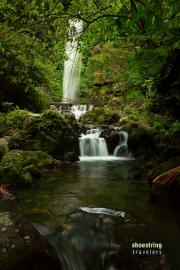The Philippines is defined by towering mountains, vast plains, and far-reaching seas. To preserve the beauty of the environment, several of these scenic spots have been declared as National Parks, wonderful treasures of the Philippine archipelago.
Location
The Mount Iglit-Baco National Park is situated in the municipality of Calintaan, Occidental Mindoro. A very fast and convenient way to get there is to take a direct flight from Manila to San Jose, followed by a long jeepney or bus ride, either to barangay Poypoy, Calintaan in the western side, or to Bongabong in the eastern side..
For a more adventurous trip, take a bus from Manila going to Batangas City and then take a ferry boat ride to Abra de Ilog which is usually 2 ½ hours. From Abra de Ilog, ride a jeepney or a bus going to San Jose which takes 6 hours, then get off at the town of Calintaan.
Elevation and Land Area
Mount Iglit has an elevation of 1,434 meters while Mount Baco is 2,488 meters high. These two adjacent mountains have a total land area of 75,445 hectares.
Flora
On an around the mountains are various common, endangered, and endemic flora that beautify the surroundings. You can find plants and trees like Anthocephalus chinensis, Artocarpus blancoi, Ficus nota, balinghasai, alibangbang and hawili. Indigenous plants that are hardly ever seen in some other regions are kamagong, tindalo, kalantas, almaciga, and the rare jade vine.
Fauna
The main of attraction in the park is the Tamaraw or Bubalus mindorensis which is the most endangered big land mammal in the world.
The site is the sanctuary of a range of endemic birds like, the Mindoro imperial pigeon, black-hooded coucal, Mindoro scops owl, scarlet-collared flowerpecker and bleeding-heart pigeon. Also, it is the home of different wild animals such as the famous Philippine deer, the Mindoro cloud rat and the wild pig.
The Mangyan
Living harmoniously with the tamaraw and nature, the Mangyan is the major indigenous group in Mindoro and is classified into at least eight ethno-linguistic groups: Iraya, Batangan, Hanuno’o,Alangan, Ratagnon, Tagaydan (or Tadyawan), Buhid and Pula. Some groups are believed to have been coastal dwellers, but have since moved into the remote forest interior to avoid religious conversion by migrants.
The Mangyan are traditionally nomadic within their territory and settle temporarily where food is found. Extended families set up loose clusters of bamboo huts with thatched roofs and raised floors. There are no formal leaders or social classes, and elders settle community disputes.
The Batangan Tau-buid and the Buhid Mangyan directly depend on Mts. Iglit and Baco for their source of food and livelihood. They grow corn and sweet potato close to their huts; others supplement these with cassava, rice, bananas, papayas, avocados, squash, beans, taro, and other vegetables. They gather edible forest products, trap wild pigs and chickens and raise domestic stock.
Both tribes are distinguishable for their earthen-tobacco pipe-smoking habits, and share a passion with their fellow Mangyan for the betel nut. The Buhid are said to be highly literate, and write in ancient scripts similar to the Tagbanua, an ethno-linguistic group of Palawan.
The Mangyan consistently stress their desire to maintain their cultural identity and ancestral domain, asserting their right to use resources for sustenance and cultural survival.
Recognition
On November 11, 1970, Mt Iglit and Mt. Baco was declared as a National Park by virtue of Republic Act No. 6148.
It is listed as one of the sites under the ASEAN Declaration of Heritage Parks done in November 1984.
The government made a law for the safety of Mount Iglit-Baco and one of them is the prohibition of hunting, destroying, disturbing or mere possessing of any plant or animal without a permit from the management. There’s a penalty, for those who don’t follow the law.
Points of Interest
The Mount Iglit-Baco is composed of at least eight major river schemes and has a rugged terrain composed of slopes, river gorges and plateaus.
Some activities that can be done here are:
Tamaraw watching. Watching Tamaraw grazing in the wild is a relaxing activity. The visitor will be spell bound by the surrounding seascape on the west side.
Tamaraw observation in captivity at the Gene Pool. Visitors can observe the Tamaraw breeding activities at the gene pool in Sitio Canturoy, Brgy Manuot, Rizal.
Bird watching. Birdwatchers will enjoy observing the birds endemic to the Park as well as other interesting ones like the Blue Shortwing, Island Thrush Tardus, Blueheaded Racket-tailed Parrot, Barred Graybird, Philippine Bulbul, and Mindoro Canegrass Warbler.
Mountain climbing. The climb to Mount Iglit starts with a one hour trek from Barangay Poypoy, Calintaan, Occidental Mindoro to Station I at Sitio Magtangcob. Another three-hour hike brings one to Station II at the foot of Mt. Iglit. From there, one can start a four to five-hour ascent to the summit. Climbers can descend to Station III at Magawang, where Tamaraws may be spotted any time of the day. So far, there have been no recorded ascents to the peak of Mount Baco because of inaccessibility. Aside from following the camping guidelines, visitors must observe and respect the culture and sacred sites of the Mangyan living within the area.
How to get there
From Manila, you can ride a bus travelling to Batangas City, then take a ferry ride going to Abra de Ilog for 2 – 3 hours. From Abra de Ilog, you can take a jeep or bus to San Jose Oriental Mindoro that passing through the town of Calintaan.
The fastest way to go there is by riding plane from Manila to San Jose, municipality of Batangas city, which cost around 1,500 – 2,000. Then from San Jose, you can ride a jeep passing through the municipality of Calintaan.










